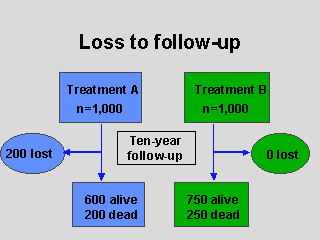 |
"Loss to follow-up" usually refers to loss of contact with a patient so that
there is no opportunity to assess outcomes. A large proportion of
participants lost to follow-up can invalidate the findings from a clinical
trial. In this example, it appears that the 10-year probability of survival
is identical for both treatment groups, 75%. However, a large number of
patients in Group A were lost to follow-up and their survival status at 10
years is unknown. If the proportion surviving in the lost-to-followup group
is different from the group for which survival is known, the conclusion that
the two treatments are equally beneficial is incorrect.
Some losses to follow-up are probably inevitable. Although this example is
extreme, it is not uncommon to find large proportions of patients lost, or
an imbalance in proportions lost to follow-up if methods of maintaining
contact are not applied diligently and equally to all treatment groups.
Intensive efforts to retain contact with patients in all treatment groups
and to identify alternative approaches to measuring outcome (such as national
vital status records) should be incorporated.
|
